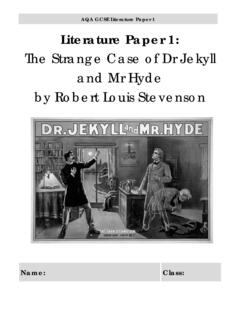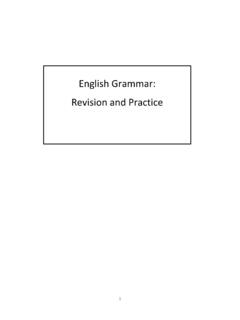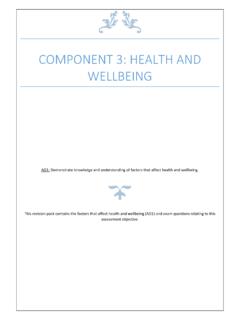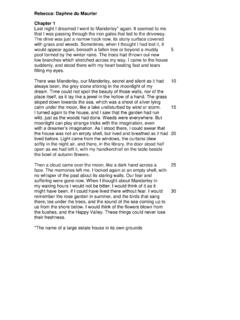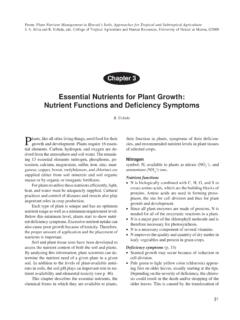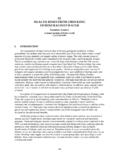Transcription of MACRONUTRIENTS: Proteins, fats, carbohydrates nutrients …
1 MACRONUTRIENTS: Proteins, fats, carbohydrates Key facts Food provides all the materials ( nutrients ) and energy that the body needs for growth, maintenance, repair and to work properly. Foods also contain (either natural or added): flavourings, colourings, ezymes, preservatives, texture Diet is the food eaten every day Special diets reduce or increase a nutrient or food, low salt diet, weight loss diet, high fibre diet. A balanced diet means eating right amount of nutrients and a variety of foods for our individual needs Malnutrition means bad nutrition (too much or too little of one or more nutrients ) PROTEINS Protein molecules are made of amino acids there are 10 essential amino acids that must come from food.
2 High biological value (HBV) proteins contain all of the essential amino acids. Low biological protein (LBV) proteins are missing one or more of the essential amino acids. Mixing LBV proteins together supplies all of the essential amino acids; this is called protein complementing ( baked beans on toast) Function (job in the body) Found mainly in these foods Result of deficiency (not enough) Children Adults Growth Maintenance Repair and healing Energy HBV: meat, fish, eggs, milk, cheese, soya beans, quinoa LBV.
3 Cereals, pulses, beans, some nuts, seeds, vegetarian alternatives, Quorn Poor growth Slow healing Catch infections easily Fluid under skin (oedema) Thin, weak Cannot digest food properly Diarrhoea Hair thinning Lose muscle, fat Internal organs weaken Dry hair and skin oedema FATS Fat is solid at room temperature, Oil is a fat that is liquid at room temperature Fat molecules are made up of one part glycerol and three parts fatty acids a triglyceride Saturated fatty acids are full of hydrogen Unsaturated fatty acids have one double bond Polyunsaturated fatty acids have two or more double bonds Hydrogenation means adding hydrogen to make a liquid oil become a solid fat Hydrogenation can make trans fats Exam tip: You may be asked to state or describe ways someone can reduce their fat intake.
4 A common mistake is to simply say eat less or add less when cooking ; these are basic statements gaining limited marks. Try instead to think about: different cooking methods grilling rather than frying; cutting off visible fat; the types of fat chosen lower fat options or leaner cuts of meat. carbohydrates carbohydrates are made by plants during photosynthesis carbohydrates provide the main source of energy for the body One type, NSP (dietary fibre), helps the body get rid of solid waste Complex carbohydrates or polysaccharides are made of long chains of glucose units joined together in different ways.
5 The main sources of carbohydrates : Sugars Complex carbohydrates (polysaccharides) Monosaccharides: Fructose: fruits, plant juices, honey Glucose: vegetables, ripe fruits, sugars used in cooking Galactose: milk Starch: root vegetables (carrots, parsnips), potatoes, yams, plantains, bananas Disaccharides: Sucrose: (glucose and fructose): sugar (granulated, caster, brown); fruits and vegetables Lactose: milk and milk products Maltose (glucose and glucose): cereals, barley, malted biscuits and milk drinks Lactose (glucose and galactose): milk and milk products A deficiency of carbohydrate (not enough) can cause: Low blood glucose levels Weight loss Athletes to hit the wall If you eat too much carbohydrate, it provides you with more energy than you will use up in physical activity.
6 The rest will be stored in adipose tissue. This leads to weight gain. Check your understanding: 1. Name two high biological value (HBV) proteins. (2 marks) 2. Give four reasons why the body needs protein. (4 marks) 3. Give three reasons why the body needs fat. (3 marks) 4. What is meant by the term invisible fat? (1 mark) 5. State 2 alternative names for sugars.
7 (2 marks) 6. Identify one good source of NSP/ dietary fibre. (1 mark) VITAMINS Water soluble and fat soluble vitamins There are two groups of vitamins: water soluble (B group and Vitamin C) and fat soluble (A, D, E and K) Water soluble vitamins are destroyed by heat and light or dissolve in cooking water. They are natural substances needed in very small amounts. Name Function (job in the body) Found mainly in these foods Result of deficiency (not enough) Water soluble vitamins Thiamine (vitamin B ) Releases energy from carbohydrates Body growth Helps nervous system Yeast, yeast extract, cereals (especially wholegrains), cereal products, meat, eggs.
8 Milk, seeds, nuts and beans. Wet or dry beri-beri Muscle wastage Riboflavin (vitamin B ) Releases energy from carbohydrates , proteins and fats Body growth Dry, cracked skin around mouth and nose Swollen toungue Niacin (vitamin B ) Releases energy from carbohydrates Can lower blood fat levels As above but can be made in the body from the amino acid trypophan Pellagra (three D s diarrhoea, dementia, dermatitis) Pantothenic acid (vitamin B ) Releases energy from food A wide range of foods Rare Pyridoxine (vitamin B ) Helps the body use protein, fat and carbohydrate Wide range of foods (small amounts in each) Headaches, weakness, aching, anaemia, skin problems Folate (vitamin B ) (folic acid is its man-made form) Helps body use protein Helps make DNA in cells, especially in the bone marrow and digestive system Helps prevent spinal cord defects in the unborn baby Green leafy vegetables, liver, potatoes, fruits (oranges, berries)
9 , asparagus, okra, beans, seeds, wholegrain cereals, nuts. Added to some breakfast cereals (fortification) nutrients not absorbed properly in the digestive system (loss of appetite, nausea, diarrhoea, mouth soreness) Faulty bone marrow cells that cannot deliver oxygen round the body this is megaloblastic anaemia Cobalamin (vitamin B ) Makes a protective coating around nerve cells Important for the correct production of new cells Can be stored in the liver found in animal foods (dairy foods, meat, fish, poultry)
10 NOT found in plant foods could be a problem for vegans. Nerves don t work properly which leads to memory loss, confusion, paralysis Pernicious anaemia Ascorbic acid (vitamin C) Helps the body absorb iron form food Needed for the production of collagen, which makes connective tissue that hold s body cells together Antioxidant-protects body from harmful chemicals Keeps skin and digestive Rich sources: blackcurrants, citrus fruits (oranges, lemons, grapefruit, etc.) Important sources: Brussel sprouts, broccoli, beansprouts, potatoes, peas, cabbage, green leafy vegetables (not Anaemia (iron not absorbed) Severe deficiency leads to scurvy (loose teeth, bleeding gums, red spots under the skin [ leakage from blood vessels], tiredness, weakness, weight loss, poor wound system healthy lettuce) healing) Name Function (job in the body) Found mainly in these foods Result of deficiency (not enough)

